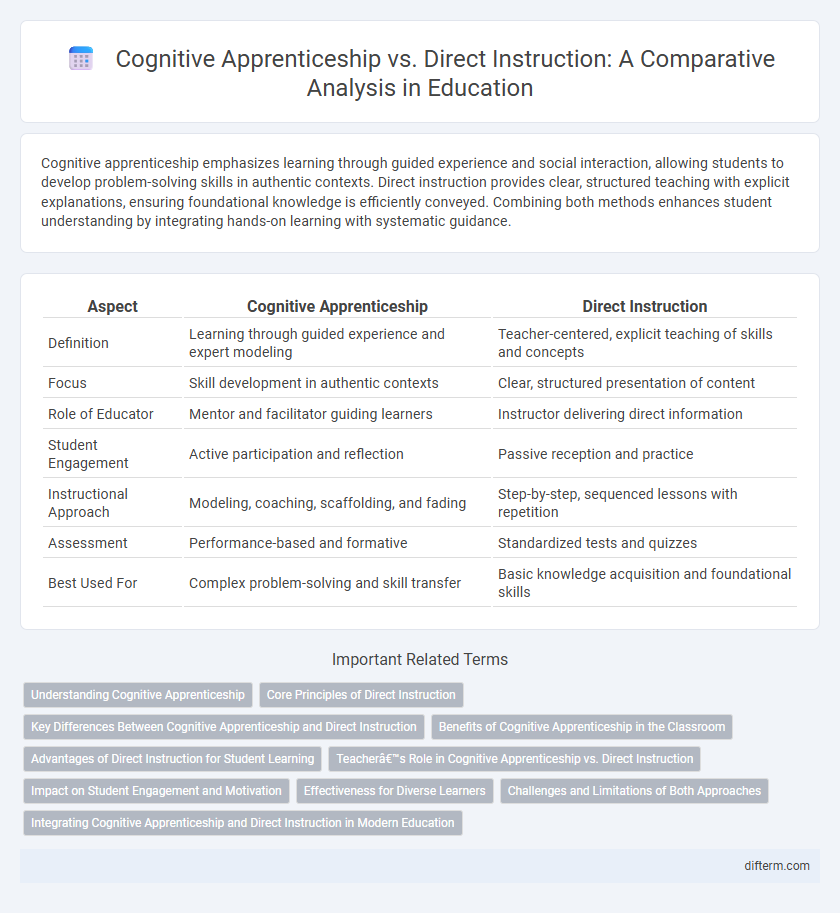Cognitive apprenticeship emphasizes learning through guided experience and social interaction, allowing students to develop problem-solving skills in authentic contexts. Direct instruction provides clear, structured teaching with explicit explanations, ensuring foundational knowledge is efficiently conveyed. Combining both methods enhances student understanding by integrating hands-on learning with systematic guidance.
Table of Comparison
| Aspect | Cognitive Apprenticeship | Direct Instruction |
|---|---|---|
| Definition | Learning through guided experience and expert modeling | Teacher-centered, explicit teaching of skills and concepts |
| Focus | Skill development in authentic contexts | Clear, structured presentation of content |
| Role of Educator | Mentor and facilitator guiding learners | Instructor delivering direct information |
| Student Engagement | Active participation and reflection | Passive reception and practice |
| Instructional Approach | Modeling, coaching, scaffolding, and fading | Step-by-step, sequenced lessons with repetition |
| Assessment | Performance-based and formative | Standardized tests and quizzes |
| Best Used For | Complex problem-solving and skill transfer | Basic knowledge acquisition and foundational skills |
Understanding Cognitive Apprenticeship
Cognitive apprenticeship emphasizes learning through guided experiences, where students observe, practice, and internalize expert thinking processes within real-world contexts, fostering deep comprehension and problem-solving skills. This method contrasts with direct instruction, which relies on explicit teaching of facts and procedures, often lacking opportunities for applied practice and mentorship. Understanding cognitive apprenticeship reveals its effectiveness in developing higher-order cognitive skills by integrating modeling, coaching, and reflection into the educational process.
Core Principles of Direct Instruction
Direct Instruction centers on explicit teaching, structured lessons, and clearly defined learning objectives, emphasizing mastery of foundational skills through guided practice and immediate feedback. The approach relies on scripted materials and systematic assessment to ensure consistent delivery and measurable student progress. Core principles include clear demonstration of concepts, sequenced instruction, and continuous evaluation to optimize student understanding and retention.
Key Differences Between Cognitive Apprenticeship and Direct Instruction
Cognitive apprenticeship emphasizes learning through guided experiences within authentic tasks, promoting skill acquisition via modeling, coaching, and scaffolding. Direct instruction centers on explicit teaching of concepts through structured lessons, clear objectives, and immediate feedback to ensure mastery of content. The main difference lies in cognitive apprenticeship's focus on contextualized, situated learning versus direct instruction's focus on systematic, decontextualized knowledge transmission.
Benefits of Cognitive Apprenticeship in the Classroom
Cognitive apprenticeship enhances learning by situating knowledge in authentic contexts, enabling students to develop problem-solving skills through guided experiences. This method fosters deep understanding and critical thinking by modeling expert strategies and providing scaffolding tailored to individual needs. Compared to direct instruction, it promotes learner autonomy and engagement, resulting in improved knowledge retention and application.
Advantages of Direct Instruction for Student Learning
Direct instruction offers structured, clear, and efficient teaching methods that enhance student comprehension and retention by providing explicit guidance and immediate feedback. It supports mastery of fundamental skills through systematic practice, helping students build a strong foundational knowledge base. Research shows that direct instruction improves academic achievement, especially in subjects requiring sequential learning such as mathematics and reading.
Teacher’s Role in Cognitive Apprenticeship vs. Direct Instruction
In cognitive apprenticeship, the teacher acts as a mentor who models expert thinking and guides students through authentic tasks, emphasizing scaffolding and gradual release of responsibility. In direct instruction, the teacher predominantly delivers structured, explicit lessons focused on clear, step-by-step teaching of concepts and skills. This contrast highlights the teacher's role shifting from a facilitator in cognitive apprenticeship to a primary knowledge transmitter in direct instruction.
Impact on Student Engagement and Motivation
Cognitive apprenticeship enhances student engagement by embedding learning in authentic tasks, promoting active participation and intrinsic motivation through social interaction and expert guidance. Direct instruction offers clear, structured content delivery that can increase motivation by providing immediate feedback and measurable progress. Both approaches impact motivation differently: cognitive apprenticeship fosters deeper engagement via contextual learning, while direct instruction supports motivation through clarity and routine.
Effectiveness for Diverse Learners
Cognitive apprenticeship promotes deeper understanding by engaging learners in real-world problem-solving and modeling expert strategies, which benefits diverse learners through contextualized and scaffolded support. Direct instruction offers clear, structured, and systematic teaching that ensures foundational skills acquisition, particularly effective for learners needing explicit guidance. Combining both methods maximizes effectiveness, as cognitive apprenticeship fosters metacognitive skills while direct instruction solidifies essential knowledge across diverse student populations.
Challenges and Limitations of Both Approaches
Cognitive apprenticeship faces challenges such as the intensive time commitment required from instructors and difficulty in scaling personalized mentorship across large classrooms. Direct instruction often limits critical thinking development and can lead to passive learning, reducing student engagement and adaptability. Both approaches struggle with balancing structure and creativity, making it essential to align teaching strategies with diverse learner needs and educational goals.
Integrating Cognitive Apprenticeship and Direct Instruction in Modern Education
Integrating cognitive apprenticeship and direct instruction in modern education enhances student learning by combining hands-on skill development with clear, structured guidance. Cognitive apprenticeship fosters critical thinking and problem-solving through modeling, coaching, and reflection, while direct instruction ensures mastery of foundational knowledge with explicit teaching methods. Blending these approaches supports deeper understanding and practical application across diverse learning contexts.
cognitive apprenticeship vs direct instruction Infographic

 difterm.com
difterm.com